
1882-1914 |
 |
| Lyon Aviation 7-15 mai 1910 | Edité pour le Champagne LÉON CHANDON | |||
| 5 - LEGAGNEUX (Sommer) | ||||
| Reproduction interdite | A. LABATY, 24, Capucines, Paris |
|
|
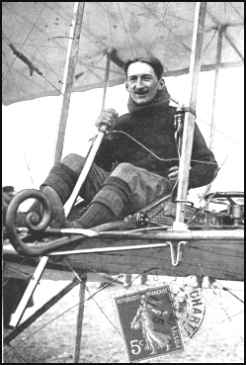 |
|
Carte postale offerte par Le Petit Journal. Cl. Branger Collection of Dave Lam, 9-3-07 |
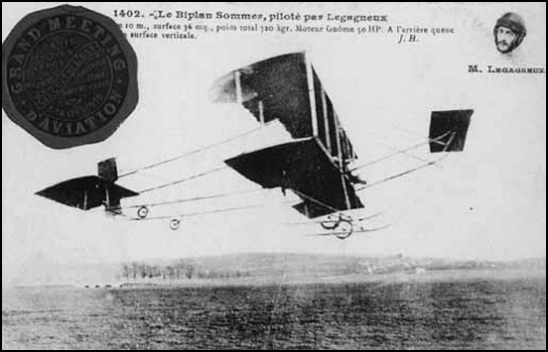 |
|
Envergure 10m, surface 36mq, poids total 320kg. Moteur Gnôme 50HP. Scale 10m, surface 36mq, total weight 320kg. Driving Gnôme 50HP. Collection of Denís Fauvel, |
|
By ERNEST JONES France The machine was flown in August by Legagneux for 256m., winning the third prize of the A.C.F. for 200m. September 5, 1908---Ferber flew for two mins., and on the nineteenth, 230m. On September 19 he made a flight of 500m. The machine was renamed the Antoinette III. June 13, 1909---In a Voisin, Ferber flew five kils. at Juvisy in 5:30. On September 15, in Boulogne, he covered 9.65 kils. in nine mins. in a cross-country flight. On September 22, in Boulogne, he was killed when his machine overturned in rolling into a ditch preparatory to attempting a cross-channel flight. |
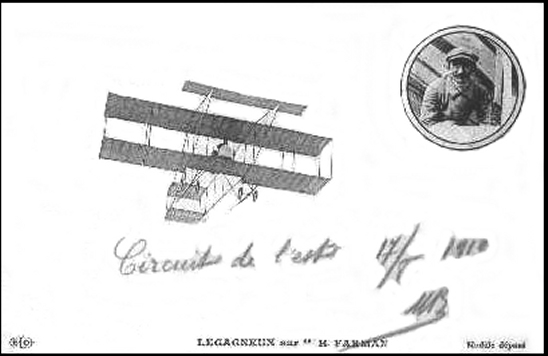 |
|
"Le circuit de l'Est 14/8 1910" Collection of Dave Lam |
|
France September 19---He flew 500m. at Issy. In 1909 he was flying a Voisin and became one of the world's foremost aviators. |
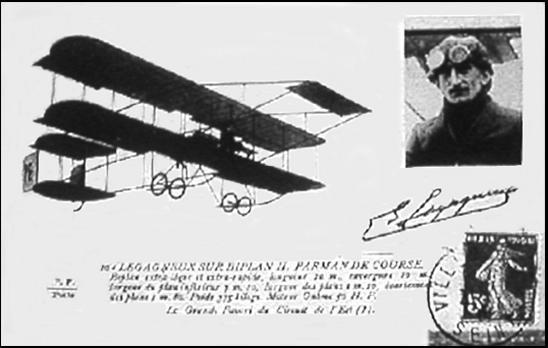 |
|
Collection of Dave Lam |
 |
|
sur Biplan Farman. Legagneux, quoique non qualifié, a accompli tout le parcours, se rendant populaire par son courage et sa gaité. 42 - Circuit of the East, Arrival of Legagneux to ISSY-les-MOULINEAUX in Farman Biplane. Legagneux, though not qualified, finished all the course, becoming popular by virtue of his courage and his gaity |
|
Daily Journal and Tribune, Knoxville, Tennessee: August 18, 1910, Transcribed by Bob Davis - 9-4-03 Parisians Forsook Their Beds Early Wednesday Morning, To Witness Finish of the Cross-Country Race. Winner's Time For the 485 Miles Traversed Was 11 Hrs., 55 Min., 59 Seconds - Paris, Aug. 17. "LeBlanc's flight from Amiens, some sixty miles, was made in the same superb style as the previous laps in the race. He left Amiens at 5:03 and descended at Issy in the suburbs of Paris, one hour and twenty-eight minutes latwer, making the total time for the 485 miles of the entire flight eleven hours, fifty-five minutes and fifty-nine seconds, an average of nearly forty miles an hour as the crow flies, without making any allowance for detours or for the time spent in battling with the storm in the flight from Mezieres to Douai last Friday. "Aubrun, whose time from Amiens was one hour and fifty-one minutes, completed the circuit in thirteen hours, twenty-seven minutes, fourteen seconds. None of the other competitors completed the entire course, though LeGagneux, who was forced to retire in the early stages of the race, finished with LeBlanc and Aubrun. "There was a moment of tumultuous cheering as LeBlanc appeared above Issy in the early dawn and from the height of nearly a quarter of a mile planed down toward the earth and swooped across the line like a giant hawk, alighting with the ease and grace of a big bird. "The authorities in expectation of the large crowd, had cordoned the alighting place at Issy with hundreds of police, backed by a regiment of culrassiers of long experience in handling the Parisian crowds. Nevertheless, the spectators in an irresistible gush broke through the line of culrassiers and police and bore the victor on their shoulders to General Brun, the minister of war, who, with his staff and other high officials, had appeared at the finish to welcome the victor. General Brun congratulated LeBlanc heartily in the name of the government. A military band struck up "The Marseillaise," but the music could scarsely be heard above the cheering of the crowd, which was echoed from the housetops throughout the vast city. Aubrun Arrives "Before the cheering for LeBlanc had commenced to die down, Aubrun, in his monoplane, shot into sight at the very point in the sky where LeBlanc had first been seen, and following the victor's wake, crossed the line and made an equally graceful landing, giving fresh impetus to the cheering. "In close succession to LeBlanc and Aubrun came LeGagneux and five army officers who had acted as escorts to the contestants in the last stage of the flight, the successful trip of eight aeroplanes across the country simultaneously and under pre-arranged conditions demonstrating to what extent the conquest of the air had been carried. "Such a gallery of spectators has never before been seen in Paris, nor has the scene been duplicated at any other place. The Eiffel Tower was chosen as a point of vantage by crowds of spectators and the towering steel structure, like the housetops and other elevated points in the city, was black with people watching the finish through field glasses or with straining eyes. "On the field at Issy, where the aviators finished, 200,000 spectators had gathered, the crowd including Prince Roland Bonaparte, General Dalstein, the military governor of Paris, and hundreds of distinguished men and women, who, when LeBlanc's monoplane was first sighted as a black speck high above the city, were seixed with a perfect delirium. Dangers of the Course "Legagneux and the military aviators were forced to take landings on the trip from Amiens interfering with their plans to convoy in the winning aeroplanes. LeGagneux, in landing at Issy, broke a wing of his bi-plane. "LeBlanc and Aubrun agree that the chief difficulty in flying across country is furnished by strong air currents and eddies over valleys and ravines along the course, which often suck down the aeroplanes from 200 to 300 feet without warning in an abrupt drop. During such experiences the aviators were able to keep their places in the machines only by clinging to the levers and framework. "Issy was also the goal for the big dirigible balloon Bayard-Clement, which arrived from Creil a short time after the bevy of heavier than air machines had alighted. Its arrival caused a further burst of cheering." Bob Davis |
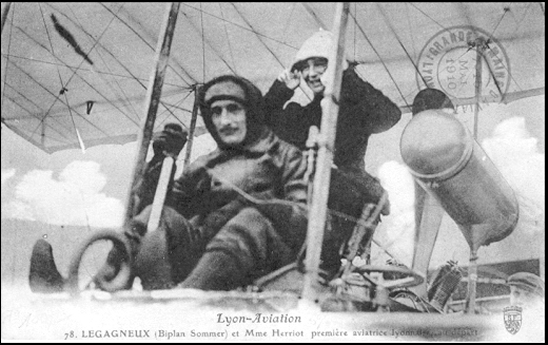 |
|
78 LEGAGNEUX (Biplan Sommer) et mme Herriot première aviatrice Lyon 78 LEGAGNEUX (Sommer Biplane) and Mrs. Herriot first aviatrice Lyon In this time period, any lady who rode in a plane was called an aviatrice; it does not imply that she was a pilot, and in fact she was not-- she was the wife of the Mayor of Lyon, and she took a ride (as did her husband) during an air show. |
 |
 |
|
Collection of Martin Hirschbühl, 7-25-09 |
|
|
|
This is a really remarkable resource and you should plan to visit each of the other nine pages so as to enjoy the many other postcards. . My sincere thanks go to Denís for his courtesy in allowing me to use images from his website to enhance the pages on this site. You can access his site by clicking on the title above. |
 |
GRANDE ENCICLOPEDIA AERONAUTICA LUIGI MANCINI Product Details Hardcover: 660 pages Publisher: EDIZIONI "AERONAUTICA" MILANO (1936) |
|
EXTRACT: Courtesy of Giovanni Giorgetti, 9-16-09 LEGAGNEUX GEORGES. Eccellente meccanico, fu collaboratore del Cap. Ferber nel 1909, indi conseguì il brevetto di pil. av. Vinse il premio dei 200 metri ad Issy il 18 agosto e, dopo avere fatto delle esibizioni a Vienna, a Copenaghen, in Austria, in Russia ed in Italia, si rivelò definitivamente al meeting di Lione (1910) su biplano Farman. Effettuò il percorso completo del Circuito dell’Est e quello del meeting dell’Havre (1911). Fece una brillante rentrée su monoplano Blériot a Bordeaux nel settembre dello stesso anno e tentò due volte con Martinet il viaggio Parigi-Bruxelles e ritorno. Il 9 dicembre 1910 si aggiudicò il rècord d'altezza salendo a 3100 m. Il 2 dicembre seguente conquistò il record di distanza con km. 515.900. Nel 1911 con l’aviatore Mortinet fondò la Scuola d'Aviazione Mortinet-Legagneux a Compiége, attribuendosi in luglio i records di velocità con un passeggero da 1 a 150 km. e nuovamente il record di altezza con m. 5450 e quello con passeggero a m. 3200. LEGANEUX, George. Excellent engineer, he worked with Captain Ferber in 1909 and shortly after he obtained his pilot licence. On the 18th of August of the same year he won the 200 metres prize in Issy. He took part in flying shows in Vienna (Austria), in Copenaghen (Denmark), in Russia and in Italy but his flying skills truly appeared at the 1910 meeting in Lyon (France), where he piloted a Farman biplane. He completed the Eastern Circuit and the one of the Le Havre meeting, in 1911. He reappered in Bordeaux (France) during September of the same year, flying a Bleriot monoplane and, together with Martinet, attempting twice the Paris - Bruxelles round trip. Previously, on the 9th of Dicember 1910 he achieved an altitude record of 3100 metres and on the 2nd of December 1911 a distance record of 515.9 Km. In the same year, again with Martinet, he founded the Martinet-Legagneux Flying School in Compiege (France), establishing in July a new speed record (from 1 to 150 km/h) while carrying a passenger and two altitude records: 5450 metres flying solo and 3200 metres carrying a passenger. |
|
Personal Communiction from David Lam, 7-7-04 Editor's Note: If you have any information on this pioneer aviator please contact me. E-mail to Ralph Cooper |


|